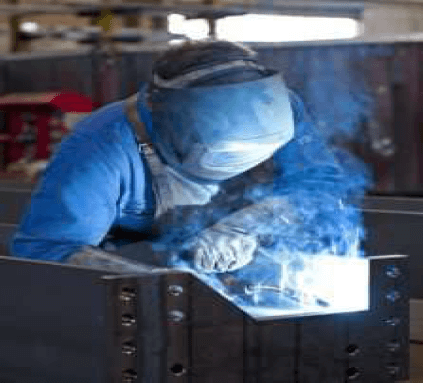MIG welding: highly dangerous despite smaller amounts of welding fumes
MIG welding is considered a highly productive and fast welding method, and is mainly used when processing non-iron metals, for example for manufacturing plants, appliances or aircraft. Compared to MAG welding, MIG welding does not use active gases, but inert and immutable gases. Mainly argon, but in individual cases also expensive helium helps to protect the weld seam from oxidation due to the external influence of oxygen from the air.
However, this is exactly the reason for the risk to the welder's health. MIG welding is a type of arc welding. The bow is crucial to maintaining high productivity. This ensures high temperatures and burns the welding wire that is rolled into a coil. This in turn is used, on the one hand, as an active electrode and, on the other hand, as input material. 95% of the dangerous substances created during welding are usually caused by the input material.
Carcinogenic despite low emissions
 MIG welding causes relatively low amounts of welding fumes compared to MAG welding, however risks can be found by looking at the details. The welding of aluminum materials releases welding fumes that include aluminum oxide. This dangerous substance is classified as a lung hazard and can cause dust deposits in the respiratory tract, especially in the lung itself. Welders can get irreversible aluminosis, which in Spain is, after all, an occupational disease subject to compensation. It's less the duration of exposure than the intensity that causes the disease. Irritation of the respiratory tract may also occur.
MIG welding causes relatively low amounts of welding fumes compared to MAG welding, however risks can be found by looking at the details. The welding of aluminum materials releases welding fumes that include aluminum oxide. This dangerous substance is classified as a lung hazard and can cause dust deposits in the respiratory tract, especially in the lung itself. Welders can get irreversible aluminosis, which in Spain is, after all, an occupational disease subject to compensation. It's less the duration of exposure than the intensity that causes the disease. Irritation of the respiratory tract may also occur.
It is also necessary to consider the ozone risk when welding aluminium alloys with MIG. The formation of the gas is mainly caused by the arc in combination with a low amount of welding fumes. UV rays are blocked from spreading because less welding fumes are released.
In addition, they are also reflected in the shiny surfaces of aluminum and stainless steel, which are the most processed materials. This is how ozone emerges in the workplace environment. More dust would promote further decomposition of this unstable gas into oxygen. Ozone inhalation leads to irritation of the mucous membranes, acute poisoning by irritating gases or pulmonary edema. Ten times more ozone is generated during MIG welding than in the TIG welding process.
Nickel alloys as a highly dangerous auxiliary material
The highest risk factor for input materials is present when welded with nickel MIG or nickel-based alloys. If these consist of a high percentage of nickel, then welding fumes include up to 87% nickel oxide. Nickel oxide in turn is classified as carcinogenic.
If nickel-based alloys also include copper, then it may be assumed that large amounts of welding fumes are created compared to working with combinations containing chromium, cobalt or molybdenum. Copper oxide becomes the main component; it is classified as toxic and can cause metal fever.
In general, the following applies to MIG welding: despite the lower amounts of welding fumes, all the hazardous substances present still show a high risk factor for MIG welding, in the same way as welding fumes.
Relevant ventilation measures need to be implemented as a change in processes using less hazardous substances is not possible for MIG welding and the improvement of the workplace does not provide the desired relief of related hazardous substances. Welders should particularly prefer direct extraction in the generation area.





